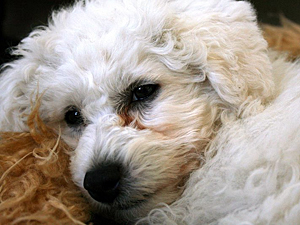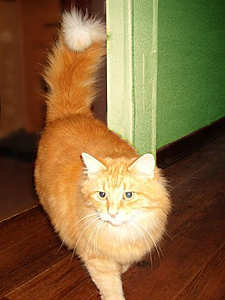
Dogs don't misbehave to get even. Rascal's accidents in the house might be prevented by giving her additional walks.
Oh, Behave! Arden Moore Advises About Dogs and Cats in the City
Looking Hangdog
Q: My 10-year-old Bichon Frise sometimes goes to the bathroom in the house when no one is home. As soon as I walk in the front door, I know what Rascal has done without seeing the accident. She acts incredibly guilty, with downcast eyes and tail between her legs. If she feels so bad when she misbehaves, why does she continue to do it? Also, I think she sometimes urinates on the floor to get even with me for being gone for too long. The longer I am away from home, the more likely she is to have an accident. Is she trying to get revenge?
A: Many owners consider their pets to be members of the family, as well they should. But sometimes, we take this idea too far by attaching human emotions and motives to our dogs' behavior. Unlike humans, dogs don't feel guilty when they have done something we think is wrong. They do, however, react to our body language and tone of voice, and they quickly learn to read and respond to our emotions.
In Rascal's case, she has figured out that if she has an accident in the house, you will be angry when you get home. It's very simple in her mind because unlike a human, she can't grasp complicated ideas like, "I had an accident and five hours later, Mom is going to come home, see it, and get mad at me because now she has to clean it up." All Rascal knows is that if she has had an accident, you are angry when you come home. Dogs have no concept of cause and effect, so unfortunately, she doesn't realize that if she didn't go to the bathroom in the house, you would not be mad.
So, if Rascal doesn't know she did something wrong, why does she look so guilty? Dogs often behave submissively when their owners are angry, in the hopes of ending the conflict. In wolf packs, subordinate members behave submissively in front of the more dominant wolves to avoid fights. Rascal tucks her tail and hangs her head when she senses or anticipates your anger to illustrate her submissiveness to you, her pack leader. Signs of submissive behavior include a cringing posture, lowered ears, downcast eyes, and a tucked tail. A canine pack leader would most likely accept this behavioral apology and move on. Unhappily, people tend to become even angrier when confronted by such signs of "guilt," which makes the poor dog cringe even more.
As for the possibility of Rascal going to the bathroom in the house to get even with you for leaving her alone too long, dogs do not have the capacity to think in these terms. Revenge remains an exclusively human endeavor, and something only a complex brain can calculate. Dogs don't have the mental ability or the emotional complexity to grasp the concept of getting even.
Rascal's accidents are most likely the result of her inability to hold her urine for long periods of time. She may be suffering from a urinary tract infection or another medical condition that makes it hard for her to hold a full bladder for an extended period of time. Older dogs often have trouble with incontinence and sometimes need medication to remedy the problem. Take Rascal to your veterinarian for a complete physical evaluation. In the meantime, try not to leave her alone for too long to help her avoid accidents. This might mean asking a neighbor or professional pet sitter to come over and let her out to relieve herself on days you know you'll be gone for a long period of time.
Excerpt from The Dog Behavior Answer Book (Storey Books, 2006) with permission from author Arden Moore (www.ardenmoore.com).

This cat's tail position indicates her confidence.
Tail as a Mood Barometer
Q: My cat, Mimi, often holds her tail straight up in the air when she walks around our house. When she sees me, her tail pops up. With dogs, I know that a relaxed, wagging tail usually means they are happy and excited. But when it comes to cats, I'm not sure how to interpret their tail signals. Do cats use their tails in the way dogs do to communicate?
A: The versatile feline tail definitely does more than act as a rudder and provide balance. Like dogs, cats use their tails to signal their moods, sort of like those mood rings in the 1970s. Remember those? They would supposedly change colors when you were happy or angry. The key difference here is that a cat's tail position is far more reliable than those mood rings were. Recognizing the messages delivered in tail talk can help you better communicate with your cat. Here are some key tail positions and what they mean.
Hoisted High. A confident, contented cat will hold her tail high in the air as she moves about her territory. A tail that is erect like a flagpole signals a happy mood or a friendly greeting. Cats often send this message as they approach a welcoming person. If the top third of the tail twitches as the cat nears you, this means that he totally adores you.
Question Mark. A tail looking bent in a question mark often conveys a playful mood. This would be a good time to engage in a five- or ten-minute play session.
Flying Low. A tail positioned straight down, parallel to the legs, may represent an aggressive mood. Be wary. That said, there are exceptions to this rule. Some breeds, such as Persians, Exotics, and Scottish Folds, normally tend to carry their tails lower than their backs.
Tucked Away. A tail curved beneath the body signals fear or submission. Something is making that cat nervous.
Puffed Up. A pipe cleaner of a tail reflects a severely agitated and frightened cat who is trying to look bigger to ward off danger.
Whipping. A tail that whips rapidly back and forth indicates both fear and aggression. It is a warning that says "stay away."
Swishing. A tail that swishes slowly from side to side usually means the cat is focused on an object. Cats often swish their tails right before they pounce on a toy mouse. It is part of their predatory positioning.
Twitching. A tail that twitches just at the tip is a sign of curiosity and excitement.
Cat-to-Cat. A tail wrapped around another cat is equivalent to a person casually putting her arm around a favorite pal. It conveys feline friendly. My cats Callie and Little Guy often stroll down my hallway with their tails touching.
Excerpt from The Cat Behavior Answer Book (Storey Books, 2007) with permission from author Arden Moore (www.ardenmoore.com).
Pet expert Arden Moore travels coast-to-coast unleashing practical tips and advice for people on how to better understand their dogs and cats. She is the author of 17 pet books, editor of Catnip, managing editor of Fido Friendly, and member of the International Association of Animal Behavior Consultants. Her books are available on Amazon.com and major bookstores. She shares her Oceanside, CA, home with four rescued pets — dogs Chipper and Cleo, and cats Callie and Murphy. Learn more by visiting her website: www.ArdenMoore.com.









